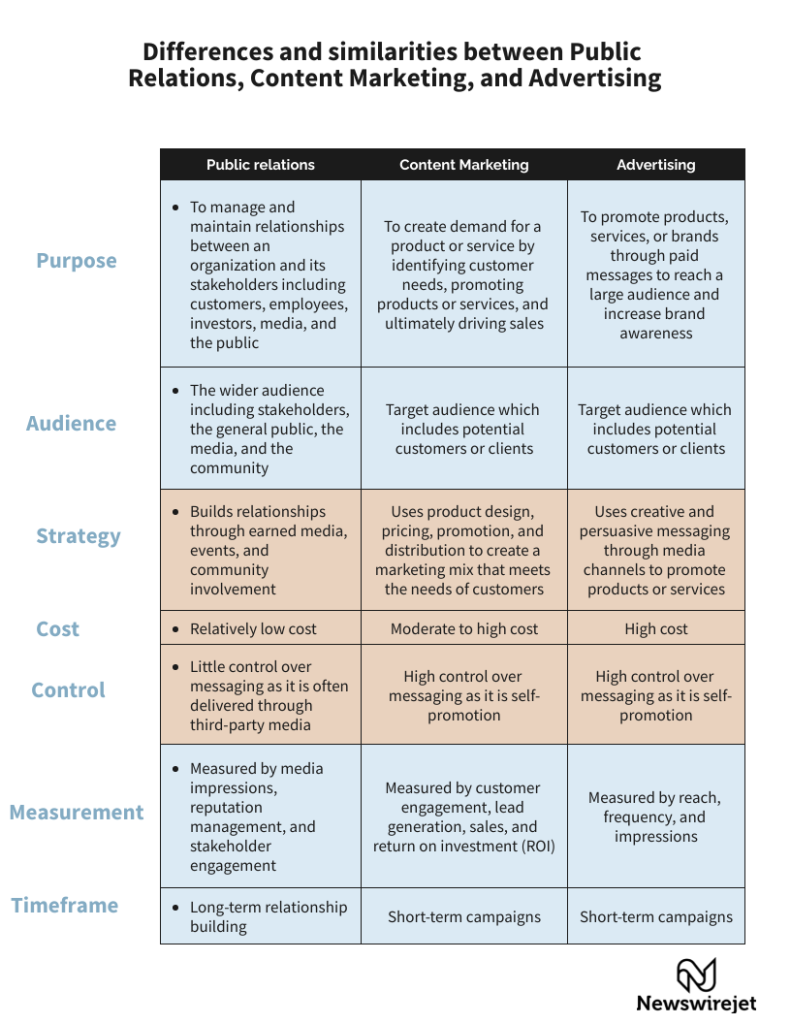Did you know that a company’s public image accounts for a whopping 63% of its value nowadays? That means any mishap or damage to its reputation can have a major impact on the company and its affiliates. This is where public relations experts come in.
PR professionals are experts in the strategic communication process that helps companies maintain a positive public image.
Having a good public relations strategy is crucial for businesses to uphold a favorable reputation, draw in customers, and cultivate a devoted following.
By prioritizing public relations efforts through methods such as writing a press release and creating effective public relations examples, companies can stay ahead of the game and ensure their success.
What Is Public Relations?
Have you ever been curious about the secret behind the success of thriving companies, individuals, and organizations? Well, the answer lies in public relations. Public relations can be defined as a strategic communication process used to create mutually beneficial and profitable relationships between the public and an entity.
Public relations plays a key role in the process of keeping a company on the lips of individuals and groups alike, by developing a specialized communication plan and using various media relations and other mediums to disseminate information and maintain a positive image of the organization or brand.
Essentially, public relations is a carefully strategized process that manages the release and spread of information related to an organization or brand to maintain a positive public image.
Beyond just cultivating a positive public image, public relations also involves establishing mutually beneficial relationships with the public through initiatives like community relations and government relations.
The Importance Of Public Relations
Public relations (PR) plays a crucial role in any organization’s success. By engaging with stakeholders, managing crises, and supporting marketing efforts, PR can help companies achieve their goals and succeed in today’s competitive business landscape.
The importance of PR can be seen in several key areas, for example,
PR helps to establish and maintain a positive image and reputation for a company. By proactively communicating with stakeholders, addressing concerns and feedback, and sharing company news and updates, PR can help to build trust and credibility with the public.
PR can also help to manage and mitigate potential crises. By developing and executing effective PR strategies, companies can build brand awareness and attract new customers. This can include media relations, influencer outreach, and other tactics aimed at reaching target audiences.
Types Of Public Relations
Public relations can be categorized into different types based on their specific functions. However, below you can find the main types of public relations and their functions:
- Media Relations
This type of PR focuses on building and maintaining positive relationships with media organizations such as TV channels, newspapers, and websites. Public relations specialists act as sources of valuable content and information for journalists, helping to ensure that the media portrays the company or organization positively. Maintaining positive media relations is crucial for positive PR and can help enhance your company’s image.
- Investor Relations
This type is all about maintaining relationships with investors, analysts, and other external parties. PR specialists handling investor relations are responsible for organizing investor events, releasing financial reports and regulatory filings, and handling investors’ queries and complaints. They work to ensure that investors have a deep understanding of your company’s success and the positive PR can help you and your team maintain a beneficial relationship with them.
- Government Relations
This type is focused on representing the company or organization to the government. PR specialists handling government relations work to ensure that the company fulfills its policies related to corporate social responsibility, fair competition, consumer protection, employee protection, and more. By maintaining positive relationships with the government, the company can positively influence public discourse and public perception of the organization.
- Community Relations
This type of PR is concerned with handling the social aspect of the company or organization. Specialists in community relations work to establish a positive reputation in the social niche and ensure that the company is viewed positively for initiatives such as environmental protection, education, and other community-oriented programs. This type of PR can help raise money and attract prospective customers.
- Internal Relations
This type involves counseling the employees of the organization regarding policies, course of action, organization’s responsibility, and their responsibility. PR specialists working in internal relations also cooperate with employees during special product launches and events, helping to ensure that everyone in the company is on the same page. This can help maintain your organization’s reputation and enhance its brand image.
- Marketing Communications
This type supports marketing efforts related to product launches, special campaigns, brand awareness, image, and positioning. PR specialists in marketing communications craft strategies to influence the target audience using paid media. Strong written and speaking engagements are critical to maintaining a positive brand image.
- Nonprofit PR
This type of PR is specific to nonprofit organizations and requires a different set of skills and strategies. Nonprofit PR specialists must work to maintain a positive public perception of the organization while also raising money and supporting the organization’s mission. Press releases and PR campaigns are essential tools for nonprofit PR specialists to utilize.
Why Public Relations?
The main objective of PR is to promote a brand using earned or free media, which comes with third-party validation and doesn’t raise public skepticism like paid ads.
At its core, public relations aims to uphold and enhance the reputation of a brand by fostering and maintaining mutually beneficial relationships with stakeholders. These stakeholders can include the public, prospective customers, partners, investors, employees, and external parties.
While company leaders have direct control over brand management, public relations strategies such as maintaining relationships through social media, running PR campaigns, and providing financial reports can help to shape the organization’s reputation positively. In contrast, negative PR can harm the organization’s reputation.
This is why many companies hire PR specialists or establish a PR department to oversee their PR efforts. Nonprofit organizations can also benefit from public relations by using it to market their mission and message to the public.
Who Is A PR Professional?
A PR professional is an individual who manages the public image and reputation of an organization or individual. The ultimate goal here for a PR is to build mutually beneficial relationships between an organization or individual and your target audience.
What Do PR Professionals Do?
PR professionals are responsible for developing and executing effective public relations strategies.
Here are some examples of what PR professionals do:
- Distributing Press Releases
Effective press releases are essential for generating media coverage and raising the client’s profile. So, PR professionals engage in various tasks, including creating and distribution of press releases. Press releases serve as a critical tool used by PR professionals to communicate newsworthy information about their clients to the media. They are written in a manner that captures the reader’s attention and highlights the essential aspects of the announcement.
- Organise Events
PR professionals plan and execute events such as product launches, press conferences, and charity fundraisers. They handle everything from logistics to promotion and use these events to create positive publicity for their clients.
- Collaborate, Design, And Execute Strategies
PR professionals collaborate with their clients to design and execute public relations strategies. This involves identifying target audiences, developing key messages, and determining the most effective channels to communicate these messages.
- Manage Crisis Communications
In the event of a crisis, such as a data breach or product recall, PR professionals are responsible for managing the client’s response and communication with the public. This involves developing a crisis communication plan, handling media inquiries, and providing updates to stakeholders.
- Establish and Nurture Relationships
PR professionals establish and nurture relationships with media outlets and journalists to ensure positive coverage for their clients. They also aim to understand the preferences and requirements of media professionals, provide them with relevant information, and respond promptly to their queries.
What is Positive Public Relations?
Positive Public Relations is the practice of creating and maintaining a positive image of a company. This involves implementing various public relations tactics, such as crafting compelling press releases, hosting events, and leveraging social media to shape the public’s perception positively.
Positive public relations aims to create a favorable image and gain the trust of the public, leading to benefits such as improved stakeholder relationships, increased sales, and an enhanced overall reputation. These days, many organizations allocate substantial time and resources to design and implement successful public relations strategies.
Example(s) Of Positive PR
Positive PR is the key to finding ways to connect with the public and build mutually beneficial relationships.
Positive PR refers to the activities undertaken by a public relations professional to create and maintain a positive reputation for a company or individual. Positive PR can take many forms, including media coverage, events, social media campaigns, and more.
Positive PR is essential for building a positive reputation and maintaining a positive relationship with stakeholders. A PR professional is responsible for managing and maintaining the public image and reputation of an organization or individual.
Positive public relations can be achieved through various methods. One effective way is by generating favorable media coverage, such as highlighting the company’s charitable activities or other positive contributions to society.
But how can positive PR be achieved? Well, positive PR can be achieved through effective customer relations, internal relations, investor relations, and marketing communications.
Utilizing social media platforms for positive PR can be an effective strategy, but it’s crucial to consider and address the possible risks and challenges that come with managing a public image through these channels.
3 Public Relations Examples
Public relations has evolved significantly over the years, from traditional media relations to more complex and comprehensive strategies that involve social media, influencer marketing, and crisis management.
In this context, some PR campaigns have stood out for their exceptional execution, creativity, and impact on the public perception of a brand or organization. Each campaign took a unique approach to messaging and engagement.
- Nike’s “Dream Crazy” Campaign
In 2018, Nike introduced the “Dream Crazy” campaign featuring NFL quarterback Colin Kaepernick, who had garnered widespread attention for taking a knee during the national anthem as a form of protest against police brutality.
The campaign also featured other famous athletes like Serena Williams and encouraged people to follow their dreams no matter what obstacles they face. Though it was a controversial outing, the campaign received a lot of praise for taking a bold stance on social issues.
- ALS Ice Bucket Challenge
The ALS Association initiated the Ice Bucket Challenge in 2014, a highly contagious social media campaign that urged individuals to pour a bucket of ice water over their heads while contributing funds to advance ALS research, commonly referred to as Lou Gehrig’s disease.
The campaign quickly went viral, with celebrities, politicians, and ordinary people alike taking part and sharing videos of their ice bucket challenges on social media.
- Dove’s “Real Beauty” Campaign
In 2004, Dove launched a campaign featuring women of all ages, shapes, and sizes, with the tagline “Real Beauty”. The campaign aimed to challenge traditional notions of beauty.
The campaign received extensive acclaim for its uplifting message and its emphasis on embracing women’s inherent beauty, significantly contributing to Dove’s positioning as a brand dedicated to promoting positive body image and fostering self-esteem among women.
Public Relations vs Marketing vs Advertising
Public Relations (PR), Content Marketing, and Advertising are closely related and are often used interchangeably. However, they have distinct differences in their purpose, audience, and strategies. Understanding the differences between them can help organizations to effectively leverage each discipline to achieve their goals.
It is for this purpose that we will highlight the differences and similarities between Public Relations, Content Marketing, and Advertising below.

Similarities Between Public Relations vs Marketing vs Advertising
Despite the differences, Public Relations, Marketing, and Advertising share some similarities:
- All three disciplines aim to promote a product, service, or brand.
- They all use communication to reach their target audience.
- They all require a deep understanding of the target audience’s needs and interests.
- They all require creativity to deliver compelling messages.
Becoming A Successful PR Professional – The How
Public relations professionals are responsible for managing the strategic communication process between an organization and its target audience.
To succeed as a public relations specialist, it is essential to;
- Possess strong communication skills, both in writing and speaking.
- Additionally, you should have a deep knowledge of community relations, government relations, and public opinion.
- You must be able to write effective press releases, design and implement public relations strategies and manage the public’s perception of your organization.
In addition to these skills, public relations managers and professionals must have a deep understanding of the strategic role that public relations plays in achieving business objectives. You must also be able to work with PR agencies, define and execute public relations strategies, and effectively manage public relations jobs.
By building a strong network of contacts, staying up-to-date with industry trends, and continually developing their skills, PR professionals can become successful in their careers.
Characteristics Of Public Relations Professionals
Public relations professionals are vital to any organization, as they are responsible for maintaining the organization’s positive image and reputation.
The job requires a unique set of skills and characteristics that enable PR professionals to effectively communicate with various stakeholders and navigate complex situations.
Here are some key traits that are essential for a successful career in public relations.
- Excellent Communication Skills
Public relations professionals must have exceptional verbal and written communication skills.
- Strategic Thinking
Public relations professionals must be able to think strategically and develop effective communication plans that align with their client’s goals and objectives. They should be able to anticipate potential problems and come up with creative solutions to mitigate any negative impact.
- Creativity
Public relations professionals should be creative and innovative, as they need to come up with engaging and attention-grabbing campaigns to reach their target audiences. They should be able to think outside the box and develop unique approaches to public relations.
- Interpersonal Skills
Public relations professionals need to be able to listen actively, empathize with others, and foster positive relationships.
- Adaptability
Public relations professionals must be able to adapt to new situations quickly. They should be flexible and able to change direction as needed to achieve their client’s goals.
- Attention to detail
Public relations professionals need to be detail-oriented and meticulous, as even small mistakes can have significant consequences. They must be able to manage multiple projects and deadlines while ensuring that everything is accurate and error-free.
- Ethics
Public relations professionals should be committed to ethical practices and transparency. They should adhere to ethical standards in their communication with clients, the media, and the public.
Steps To A Successful Public Relations Career Path
Public Relation is a dynamic field that offers a wide range of career opportunities. It is a rapidly growing industry that demands professionals with different skills and backgrounds.
Below, we shall discuss some of the most popular public relations career paths and what they entail.
- Public Relations Specialist
A public relations specialist is responsible for creating and executing public relations campaigns that help promote a positive image for their clients. They may work in-house for a company or organization or a public relations agency.
- Public Relations Manager
A public relations manager oversees the public relations activities of a company or organization.
- Corporate Communications Manager
A corporate communications manager develops and implements communication strategies to help the company achieve its goals and maintain a positive public image.
- Government Relations Specialist
A government relations specialist works with government officials and agencies to develop and implement public policy initiatives that benefit their clients. They may work in-house for a company or organization or a government relations firm.
- Investor Relations Officer
An investor relations officer is responsible for communicating with investors and shareholders about a company’s financial performance and prospects. They develop and implement investor relations strategies and work closely with senior management to ensure that investor relations activities align with the company’s overall goals.
- Crisis Communications Specialist
A crisis communications specialist is responsible for managing a company’s response to a crisis or emergency that may affect its reputation or business operations. They develop and implement crisis communications strategies and work closely with senior management to ensure that the company’s response is effective and consistent with its overall values and mission.
The Role And Importance of Public Relations in Today’s World
Public Relations is important for shaping public opinion, building relationships, and maintaining a positive image for individuals, organizations, and governments. PR professionals use various tools and tactics, such as media relations, community outreach, and social media, to create positive perceptions and foster beneficial relationships with their target audience. Successful PR professionals have excellent communication skills, strategic thinking, creativity, and adaptability. The field of public relations offers many career paths, including corporate communications, government relations, nonprofit PR, crisis management, and more.
FAQs
Q: What Is The Importance Of Public Relations For A Client’s Reputation?
A: Public relations plays a crucial role in managing and maintaining a client’s reputation. It involves strategic communication efforts to shape public perception, build trust, and mitigate any potential damage to the client’s image.
Q: How Can Writing Press Releases Benefit A Company’s Image?
A: Writing press releases is an essential tool in public relations. It allows companies to effectively communicate their news, achievements, and milestones to the media and the public. Well-crafted press releases can enhance a company’s image by generating positive media coverage and increasing brand visibility.
Q: How Do Public Relations Specialists Build Mutually Beneficial Relationships?
A: Public relations specialists build mutually beneficial relationships by establishing and maintaining connections with various stakeholders, such as the media, customers, investors, and community members. They engage in strategic communication, networking, and collaborative efforts to foster positive relationships that benefit both the organization and its stakeholders.
Q: What Is The Role Of A Public Relations Society?
A: A public relations society is a professional organization that brings together public relations practitioners, providing them with networking opportunities, educational resources, and industry insights. These societies play a vital role in promoting best practices, fostering professional development, and advancing the field of public relations.
Q: How Can Public Relations Impact Business Decisions?
A: Public relations can significantly impact business decisions by providing valuable insights into public opinion, market trends, and stakeholder expectations. Effective public relations strategies can influence decision-making processes by considering the potential reputation and public perception consequences of various business choices.
Q: What Is The Difference Between Public Relations And Public Affairs?
A: Public relations and public affairs are closely related but have distinct focuses. Public relations involves managing the communication and relationships between an organization and its various publics, such as customers, employees, and the media. Public affairs, on the other hand, specifically deals with managing the relationship between an organization and government entities, policymakers, and regulatory bodies.
Q: How Do Press Releases Contribute To Public Relations Efforts?
A: Press releases are an integral part of public relations efforts as they allow organizations to disseminate information to the media and wider public. By providing journalists with newsworthy content, press releases help generate media coverage, raise awareness, and shape public perception.
Q: Are There Any Professional Bodies Or Associations For Public Relations Practitioners?
A: Yes, there are several professional bodies and associations for public relations practitioners. These organizations, such as the Public Relations Society of America (PRSA) and the Chartered Institute of Public Relations (CIPR), offer resources, networking opportunities, certifications, and professional development programs to support public relations professionals in their careers.
Q: Can You Provide An Example Of A Successful PR Stunt?
A: One notable example of a successful PR stunt is the “Ice Bucket Challenge.” It gained widespread attention and participation on social media, where individuals filmed themselves pouring a bucket of ice water over their heads to raise awareness and funds for ALS (Amyotrophic Lateral Sclerosis) Research.
Q: How Can Public Relations Positively Impact A Company’s Brand Image?
A: Public relations can positively impact a company’s brand image by strategically managing its reputation, building strong relationships with stakeholders, and effectively communicating its values and messages. Through media relations, community engagement, crisis management, and other PR strategies, companies can enhance their brand image and differentiate themselves in the market.


